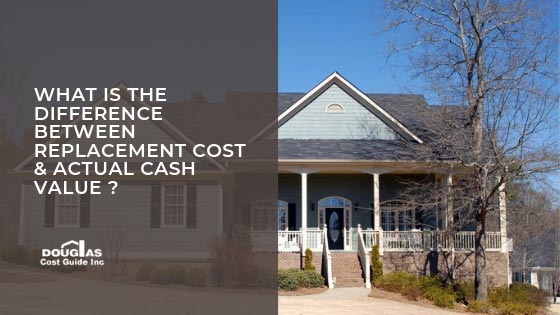There is a lot of technical jargon and insurance terms thrown around when setting up a homeowner’s policy. Terms like actual cash value and replacement costs are two of the biggest mysteries. These are calculation methods used by insurance companies to determine how much you’ll receive from your policy to cover your home if it’s been damaged.
What is Replacement Cost Insurance?
Home replacement cost is a very important element of a homeowner’s policy; even when insuring your home for actual cash value, the replacement cost of your home is used as a baseline to determine a payout amount in the event of a loss. In addition to acting as a baseline for homeowner’s policies, replacement cost is as it sounds: it is the dollar amount it would cost your insurance company to completely rebuild your home from the ground up in the event of a total loss. In essence, how much would it cost your insurance company to put you in the same dwelling you were in prior to the loss to rebuild your home from the ground up using current construction materials and techniques? The answer is your home replacement cost.
What Does Actual Cash Value Mean?
At its essence, actual cash value insurance is replacement cost less physical and functional depreciation. It is the value of your home after considering wear and tear, age, and functionality among other factors. For example, if a storm passes through an area and destroys a portion of a home’s roof, shingles will need to be replaced. If the shingles on the roof were 25-year shingles that were installed 10 years ago, the insurance company will calculate depreciation on 25-year shingles to determine the worth of the shingles after 10 years of use.
Considering Depreciation When Determining ACV
Depreciation is the leading indicator in determining actual cash value. In addition to considering depreciation to calculate a payout amount, actual cash value insurance also makes a portion of any loss the policyholder’s responsibility. For example, if the replacement cost of a home is determined to be $100,000 but actual cash value coverage of $80,000 is chosen instead, the home is insured for 80 percent of its replacement. This makes 20 percent of its replacement the policyholder’s responsibility, which also makes 20 percent of any losses the policyholder’s responsibility as well.
In the case of the damaged roof, depreciation would be calculated to determine the price for 10-year-old shingles. Once the depreciated amount is determined, 20 percent of the amount would be deducted, and the remaining 80 percent would be paid to the policyholder. Only in the event of a total loss would the full amount of a loss be paid. If a home insured for an actual cash value of $80,000 is completely lost, the full amount of $80,000 would be paid to the policyholder.
What is the Difference Between Actual Cash Value and Home Replacement Cost?
What is the difference between actual cash value and replacement cost for a residence? In short, actual cash value is reimbursement for the cost of an actual loss. If you lose a 10-year-old roof, the actual cash value of a 10-year-old roof will be paid. With replacement cost, the insurance company would pay for the roof to be repaired or replaced with new shingles. Replacement cost insurance is the coverage needed to replace things in the event of a loss. Actual cash value insurance is the coverage chosen if you simply want monetary compensation for a loss.
In the event of a total loss, replacement cost insurance would rebuild your house from the ground up to put you in the same position you were in before the loss. Actual cash value would provide you with the cash value of the loss, allowing you to move elsewhere and start over.
Which is Better Replacement Cost or Actual Cash Value?
Both replacement cost and actual cash value have pros and cons. Which one you need will depend on what works best for your property, items, and budget. For many homeowners, receiving the replacement value for your home and belongings is a better option as it allows you to replace things without needing to use your own money. If you have a large amount of savings or other assets, the actual cash value may be the best option. Here is a simple breakdown of the pros and cons for actual cash value vs home replacement cost.
Replacement Cost
Pros
- You receive claims payment that lets you adequately replace your lost items
- You don’t have to use your own money
Cons
- Higher premiums
Actual Cash Value
Pros
- Avoid higher premiums
Cons
- To purchase new items to replace the ones you’ve lost, you will have to pay the difference between the insurance payout and the cost of the new item
Another thing to consider when choosing actual cash value insurance is proving proof to your provider of items lost. The more detailed list you can provide, the easier it will be to determine the current value. If this is something you don’t plan on doing, replacement cost insurance may be the best policy for you.
How Do You Determine your Home’s Replacement Cost and Actual Cash Value to Ensure You’re Covered Appropriately?
This is where Douglas Residential Cost Guide comes in to play.
By using Douglas Residential Cost Guide you can determine what the replacement cost of your home would be and decide if replacement cost or actual cash value best suits your needs. Check out Douglas Residential Cost Guide today to ensure your home is fully protected.

